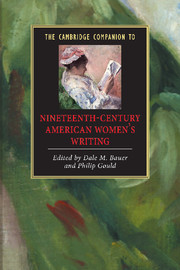3 - Antebellum politics and women's writing
from Part I - Historical and theoretical background
Published online by Cambridge University Press: 28 May 2006
Summary
Clothes-talk
In 1851, when temperance advocate Amelia Jenks Bloomer adopted a shortened shirt worn over what were called, at the time, Turkish “trowsers,” she had no idea that her married name would give to the English language a new plural noun, bloomers. As originally worn by suffragettes like Bloomer herself, or Elizabeth Smith Miller, Elizabeth Cady Stanton and Susan B. Anthony (among a host of other, less famous women, and not always those sympathetic to the suffragettes), it was regarded as a garment that could free a woman from the confinements of more traditional styles. In the 1850s a woman's daily garb consisted of ten to twelve pounds of “starched flannel or muslin petticoats,” stays, and a tightly laced corset of whalebone; these underthings were covered by full-skirted dresses “that reached to the ground, sweeping up dirt and debris from country roads and unpaved city streets” (Coon, Hear Me Patiently, 9). Dragging in mud, heavy as lead and hot as Hades, these confining clothes did not promote mobility; indeed, it was generally thought that trousers, when considered merely as an item of dress, were far more comfortable and hygienic than women's wear. Certainly, trousers offered mobility, as African-American abolitionist and diarist Charlotte L. Forten (later Grimké) reported on Saturday, July 15, 1854; she donned the “'Bloomer' costume” so as to climb “the highest cherry tree . . . Obtained some fine fruit and felt for the time 'monarch of all I surveyed'” (Grimké, Journals, 86). And as Elizabeth Cady Stanton wrote, after wearing the Bloomer for the first time, “What incredible freedom I enjoyed!” (Stanton, Eighty Years and More, 201; Kesselman, “'Freedom Suit'”).
- Type
- Chapter
- Information
- Publisher: Cambridge University PressPrint publication year: 2001
- 1
- Cited by



